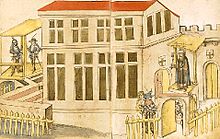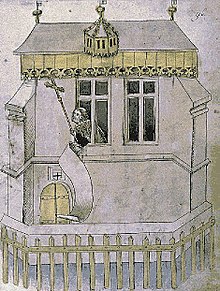Council building Constance
The council building (actually a department store ) is a sight in Constance on the shores of Lake Constance. The three-storey, massive stone building with a hipped roof was built in 1388 as a warehouse for traveling and local traders and served as a transhipment point for merchandise at the port of Constance for almost 500 years. During the Council of Constance in 1417, the conclave for the election of Pope Martin V took place in this spacious building. It is considered to be the largest preserved medieval secular building in southern Germany and has been used as a restaurant, ballroom and congress center since 1912.
history

Trading house
The decision to build goes back to a visit by a delegation of Milanese merchants in 1387. They were looking for a base for long-distance trade, because Swiss wars had changed the south-north route across the Alps. At that time, a large part of the trade goods between northern Italy and the Upper Rhine ran via Constance .
The department store was built by the Free Imperial City of Constance . A resolution of the council of 1387 stipulated that “one should make a house in which one should take good care of the whales of Mailan and other devout people, and that one should not leave” (“A house should be built in which the goods of the Welschen from Milan and other pious people can be supplied and kept, and it should be permanent ”). Construction under the direction of the master Arnold began in March 1388 and lasted until 1391. The house was handed over to its intended use as a warehouse. Goods were temporarily stored on the ground floor, durable goods were stored and the shops were operated on the upper floor. Erected on a foundation of hundreds of oak piles in the damp lake floor, it stood directly on the lake shore at that time and was part of the eastern city fortifications ( city wall ). It was therefore not far from the important marketplaces on the Marktstätte (south) and the fish market (north). In front of the structure, a flat landing stage was piled up into the lake . Cranes were installed in the bay windows with which goods could be lifted directly from the ships or the shallow landing stage to the upper floors. The goods came from the mouth of the Rhine by ship across the lake to Constance.
Council


In 1417, during the Council of Constance , the election of the new Pope took place here, which was supposed to end the Great Western Schism . The large council sessions themselves took place in the Constance Minster . The department store was the largest secular building in the city and could also be converted to be "spy-proof". There was great fear among the council members that the election might in some way be challenged and not be valid. Therefore the windows were closed except for a narrow slit; a fence was drawn around the building, and numerous guards made it a military security area. The interior was divided into 56 individual cells, where all cardinals and six representatives from each of the five participating nations were accommodated. The conclave lasted from 8 to 11 November 1417 and ended with the promulgation of papam Habemus : Oddo di Colonna was the new single and Pope Martin V. elected. The papal coronation took place on a grandstand in front of the Konstanz Minster.
The election of the Pope was the only important sacred event in the history of the building. It served as a trading house until the 19th century; Trade fairs were also held here. An inscription on the south side of the council commemorates the end of the schism.
Other uses
Because the city did not have the money to maintain it, the customs authorities moved into the building in 1836 and added a low extension, the so-called “cartridge pocket”. The present port facilities were built between 1839 and 1842, moving the lakeshore away from the department store. Constance was connected to the rail network in 1863 . The railway line passed the building to the west, and a track was laid through the ground floor - but this has now been removed. The last third of the 19th century was dominated by discussions about the future fate of the building. Several neoclassical and neo-Gothic remodeling designs were delivered, but not carried out for financial reasons.
The building was used by customs until 1872. Thereafter as a market hall until 1910. At the end of the First World War, the council building served as a military hospital. The council restaurants with a terrace in front are in the cartridge pocket.
Restaurant and ballroom
Finally, in 1910, the conversion to a restaurant and ballroom was approved. The renovation lasted from 1910 to 1911. A restaurant, a concert hall for around 600 people, a garden terrace and a large congress and ballroom with modern technical facilities were built. Among other things, the "cartridge pocket" was torn down and a new guest room was built, and the east side of the building was raised by 22 centimeters, as it had sagged a good half a meter over the centuries compared to the west side. The Constance city architect Paul Jordan designed the foyer and the stairs. The inauguration took place on May 14, 1912.
Another renovation followed in the years 1967 to 1970. The historical building fabric was secured, the gastronomic area renewed and technically modernized, the electrical and sanitary systems and fire protection equipment renewed and the roof re-covered with old tiles, but new battens. On March 15, 1970, the renovated building was ceremoniously reopened. In addition to the restaurant, the “Council” is now used for congresses, concerts, carnival events and private celebrations.
architecture
The department store or council building stands on a heaped-up area on the shores of Lake Constance directly at the port of the city of Constance . Its base is a rectangle 23 meters by 50 meters. The two floors together are about eleven meters high. Above it rests the mighty hipped roof with a ridge height of 28 meters. While the eaves on the city side is pulled down to the second floor, the building on the lake side is three-story and has two cantilevered oriel extensions at the corners . A former third central bay on the lake side is missing today. On the lake side there is a terrace and a flat extension (built in 1911), which serves as the dining room of the restaurant.
The lower two floors are divided into three-aisled halls, each with eight axes. 14 mighty wooden pillars each support the ceiling construction. The upper and lower halls are decorated with historical frescoes . The frescoes in the Upper Hall are by the Munich-based history painter Friedrich Pecht and his colleague Fritz Schwörer and were created between 1869 and 1876. They depict scenes from the city's history. The haberdashery manufacturer Hans Prym (heir to William Prym GmbH & Co. KG ) donated two colossal paintings in 1913 for the lower hall , which the Karlsruhe art professor August Groh made in the Art Nouveau style . The picture on the lake side shows a medieval barge, on the town side there is a medieval dance scene with musicians. In 1937 , the Constance painter Sepp Biehler created a series of frescoes in the council restaurant that depict the history of Lake Constance shipping.
Designation of the building as a council
The name goes back to the antique dealer Josef Kastell, who exhibited memorabilia from the papal election in the council hall from 1824. This gave rise to the name “Council building” in the 19th century. Today the building is locally called simply "Council".
literature
- City of Konstanz (Hrsg.): Festschrift for the reopening of the council building March 15, 1970. Konstanz 1970.
- Caroline Bleckmann, Michaela Jansen and Stefan King: Kaufhaus am Hafen (Council). Leaflet for the Open Monument Day 2010. Culture on the move - travel, trade and traffic. Regional Council Stuttgart / Freiburg, City of Constance.
- Caroline Bleckmann, Michaela Jansen: Buildings, built, demolished. The structural development at the Konstanzer Kaufhaus , in: Writings of the Association for the History of Lake Constance and its Surroundings , Issue 131 2013, ISBN 978-3-7995-1719-5 , pp. 3-31.
Web links
Individual evidence
- ^ A b Caroline Bleckmann, Michaela Jansen and Stefan King: Kaufhaus am Hafen (Council). Leaflet for the Open Monument Day 2010. Culture on the move - travel, trade and traffic. Regional Council Stuttgart / Freiburg, City of Constance.
- ^ Ulrich Büttner, Egon Schwär: The council building. Why did the papal election take place in a department store? In: Ulrich Büttner and Egon Schwär: Konstanzer Council story (s) . Publishing house Stadler. Constance 2014. ISBN 978-3-7977-0580-8 . Pp. 111 to 113.
- ^ Ulrich Büttner, Egon Schwär: The council building. Why did the papal election take place in a department store? In: Ulrich Büttner and Egon Schwär: Konstanzer Council story (s) . Publishing house Stadler. Constance 2014. ISBN 978-3-7977-0580-8 . Pp. 111 to 113.
- ^ Ulrich Büttner, Egon Schwär: The council building. Why did the papal election take place in a department store? In: Ulrich Büttner and Egon Schwär: Konstanzer Council story (s) . Publishing house Stadler. Constance 2014. ISBN 978-3-7977-0580-8 . Pp. 111 to 113.
- ↑ Heike Thissen: cartridge pouch. Strapped on like an accessory. In: Eva-Maria Bast and Heike Thissen: Secrets of the homeland. 50 exciting stories from Constance. Volume 2. ISBN 978-3-9815564-6-9 . Pp. 112-114.
- ^ Ulrich Büttner, Egon Schwär: The council building. Why did the papal election take place in a department store? In: Ulrich Büttner and Egon Schwär: Konstanzer Council story (s) . Publishing house Stadler. Constance 2014. ISBN 978-3-7977-0580-8 . Pp. 111 to 113.
Coordinates: 47 ° 39 '39.4 " N , 9 ° 10' 41.4" E

